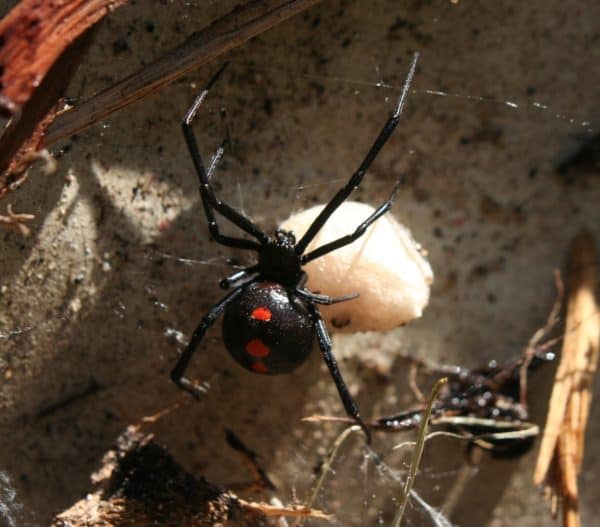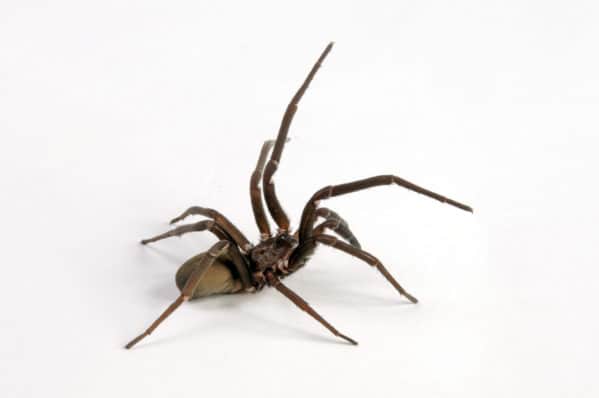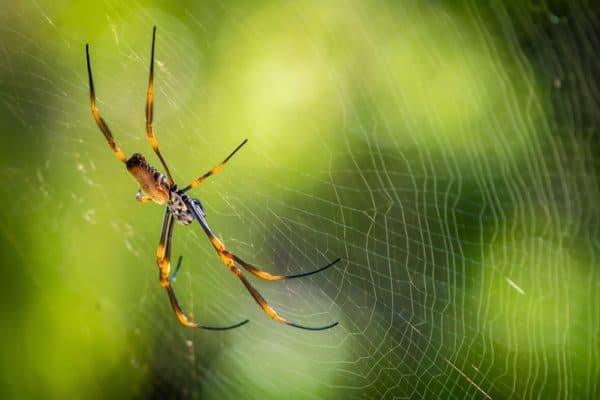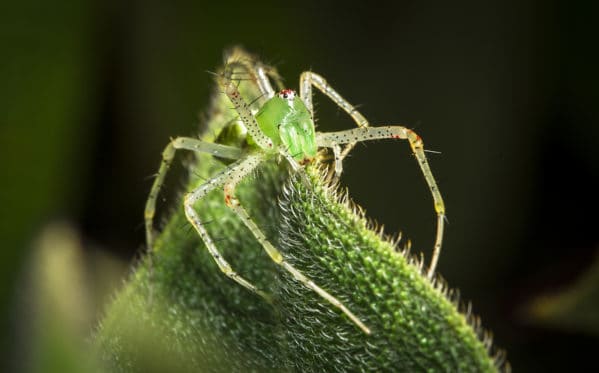READY TO GET STARTED?
REQUEST A FREE ESTIMATE
Fill out the form below or call (888) 466-7849 for a free, no-obligation estimate.

Some pests hibernate when the weather gets colder, while others seek out warmth inside of our homes. These overwintering pests will sneak through any open crevice or gap from the exterior of your home and can stay there all winter long undetected. Here are a few crawly pests that could be hiding out in your house!
German Cockroaches
The German cockroach is a common roach species found throughout the world. These roaches range from 1/2 to 5/8 inches and are brown with two-longitudinal stripes running down the thorax. They prefer to live in smaller areas close to food and moisture, such as inside pantries, basements, and bathrooms. Roaches are dangerous as they can contaminate food sources, spreading bacteria and human pathogens by leaving their fecal matter and other debris in and around food and food preparation areas.
To prevent cockroaches, make sure you keep your kitchen counters clean and free of crumbs. Vacuum frequently and always dispose of the garbage regularly. Look out for any leaks in the kitchen and bathrooms, as this moisture will attract roaches.
Brown Recluse Spider
Measuring the size of a quarter, the brown recluse spider can exist in large numbers. These spiders have six eyes arranged in three pairs, which is quite different from other species of spiders that have eight eyes arranged in two rows. The brown recluse prefers to live in dark areas such as under furniture, in wall voids, basements, crawl spaces, and in closets. While these spiders typically spin their webs in darker places, they can also found in cardboard boxes, along window molding, and even in shoes. The brown recluse can be dangerous to humans, as they will bite and inject venom if disturbed or threatened.
To prevent these spiders from entering your home, keep the trees and shrubs trimmed away from the house and roof. Repair any loose siding or shingles as they can easily sneak in through any gaps and openings. Consider installing a mesh cover or cap over chimneys to prevent entry.
Bed Bugs
Bed bugs are 3/16” to 1/4” in length or about the size of an apple seed or a pencil eraser. They are long and brown, flat in shape with an oval-shaped body, and brown in color. These pests enjoy harboring in cracks and crevices during the day and will come out at night to feed. You will typically find them in beds, mattresses, box springs, rails, headboards, and footboards. Bed bugs will bite humans on areas of skin that are exposed during sleep. Bed bugs are also notorious for hitchhiking from place to place through luggage, following you back home after traveling.
To prevent bed bugs, routinely check linens, mattresses, and even pet beds for live bugs. Thoroughly inspect any used furniture before bringing it inside your home. If you have recently travelled, inspect your luggage before bringing it inside your home, immediately take your clothes out and wash them in hot water, and dry them on high heat.
If you suspect that you have any of these pests inside your home, consider reaching out to your local pest control company where they can help identify, inspect, and provide a prevention plan.

One of the most common questions that arises when a spider is found in a home is “is that spider poisonous?” That’s a trick question. Most spiders are poisonous, yet only a handful are venomous. Poisonous spiders release their toxins when they are inhaled, ingested or absorbed through the tissue or skin; in other words, they’re only harmful if you eat them. Venomous spiders, on the other hand, inject their toxin with a fang-like apparatus known as a chelicerae. These are the spiders you should be worried about and avoid contact with.
While there are more than 20 species of spiders in Georgia, there are only 2 that are known to be dangerous to humans: the black widow and the brown recluse. Like most common spiders, biting humans is a last line of defense. They are more likely to flee, hide, or even play dead rather than bite a human. It takes a long time for a spider to replenish his supply of venom after he injects it. Most will only use this defense mechanism if they have no other choice. Wasting venom on a human can even cause the spider to starve to death before his supply is replenished as he will have no means to kill any prey he catches.
Let’s take a closer look at each of the venomous spider species in Georgia, as well as some general tips to prevent spiders from getting into your home.

The black widow spider is considered to be the most venomous spider in North America. It is only the female black widow, however, that is dangerous to humans. Black widows are a red and black spider that is usually about 1.5 inches long with a shiny, globular abdomen and a reddish hourglass shape on its underside. While they are mostly black in color, they can sometimes be brown. The venom of a black widow spider is reportedly 15 times stronger than that of a rattlesnake. While black widow bites can be fatal to the young, the elderly, and those with compromised immune systems, most victims suffer no serious or long term damage from the bite. Black widows are not aggressive and bites commonly occur as a result of accidental contact. Common symptoms from a black widow bite include redness, swelling and tenderness at the site of the bite, muscle aches, nausea, and sometimes paralysis of the diaphragm which can cause difficulty breathing.

The brown recluse spider is also known as the violin spider or the fiddleback spider. The brown recluse is a light brown spider with a dark, violin-shaped marking on its back with the neck of the violin pointing toward the rear of the spider. They also have a very distinctive eye pattern with a semi-circular arrangement of 6 eyes (3 sets of 2) while most spider species have 8 eyes. Adult brown recluses are about the size of a quarter. They usually live outdoors under rocks, woodpiles, logs, etc. but are also well adapted to living indoors with humans. Once inside they are commonly found in attics, garages, basements, and are even known to wander into shoes, clothing, and bedding. They hunt at night and retreat to dark, secluded places in the daytime. The brown recluse is typically not aggressive and usually only bite when they are inadvertently trapped against human skin (rolling over on them in the bed or slipping your foot into a shoe they have crawled into for hiding). While bites are rare they can cause serious wounds and infections. The majority of bites remain localized, becoming red, swollen and tender at the site of the bite. If left untreated, a necrotic lesion may develop, usually accompanied by a central blister.
Keep your garages, attics, sheds, basements, and other areas that aren’t utilized often clean and clear of clutter. Try to avoid leaving clothing and shoes on the floor and store them in plastic bins if possible. Shake out any clothing that has been left on the floor or in a hamper before wearing or washing.
Seal any cracks and crevices around your home. Spiders can get in through damaged window screens or cracks in your siding. Inspect the outside of your home seasonally and make any repairs necessary.
Inspect any items that are brought from outdoors into your home. This includes any packages delivered to your porch or steps, groceries that may be placed on the driveway or porch as you are unloading, boxes of decorations being brought in from storage, or used appliances that are bought secondhand.
Contact a licensed pest control company if you suspect you have a spider problem. A professional pest control technician can inspect the exterior and interior of your home to help identify any possible entry points, identify the type of spiders and other pests you may be having issues with, and properly, safely, and effectively treat any pest problems they may encounter.
Request a Free Estimate to Get Started.
Avoid Bites and Stings This Summer
The Summer Big Three: Roaches, Mosquitoes, & Termites

The climate of Georgia (and the southern United States in general) provide the ideal environment for several species of spiders. The humidity and subtropical conditions provide just the right setting for these pests to thrive. Almost all species of spiders found in the United States pose no threat to humans. In fact, of the 38 known species of spiders in Georgia, only 2 are harmful to humans. Here are 10 of the most common spiders found in Georgia and the threat they may pose to you and your family.

Black widow spiders are black and shiny in color with a prominent red hourglass shape on their back. They are most often found around woodpiles and can easily access your home by hitching a ride inside on your firewood. They are also found in common places around your home where they can be undisturbed like eaves, empty boxes, and even shoes that are stored away and never worn. Black widows can be harmful to humans if bitten. While males rarely bite, females have been known to be aggressive especially when they are guarding their eggs. Black widow bite symptoms include fever, elevated blood pressure, nausea, and sweats. Death is uncommon after a black widow bite, especially if treatment is received quickly. In fact, there has not been a black widow related death in the United States in over 10 years.

Brown recluse spiders are light to dark brown in color (hence their name) with a signature dark brown violin shape on their backs. They are commonly found outdoors in debris and woodpiles. If they are found indoors, they are usually found underneath furniture, inside storage bins, and in dark recesses like baseboards. They are often found hiding out in closets, attics, and crawlspaces. Brown recluse spiders will bite when on the defensive. These bites are very painful and often leave an open, ulcerating sore that must be treated by a medical professional. Other symptoms include fever, restlessness, and difficulty sleeping.

House spiders vary in color but most are yellow to brown in color with elongated abdomens. They are most often found inside homes (hence their name) usually in ceiling corners, under furniture, and inside closets, basements, garages, and crawlspaces. When outdoors, they are often found around windows, under eaves, and near light sources. While they can be a nuisance to have in your home, they don’t pose any threat to humans. Because of the low humidity and fewer insects in modern homes, house spiders are becoming less common in houses and more likely to be found in garages, sheds, barns, and warehouses.

Wolf spiders are typically dark brown in color with pale markings or stripes. Their legs are long and spiny and most have hair on their bodies. When indoors, wolf spiders typically stay on or near the floor, especially along walls and under furniture. They often come inside on firewood. When found outside they are usually found under firewood piles, leaves, yard debris, and stones and will often hide in these places during the day. While wolf spiders can bite, these incidents are rare and they don’t pose a significant threat to humans. Wolf spiders are unique in that they don’t capture their prey in webs but rather by chasing them down using their speed.

Crevice spiders have similar shapes and coloring as brown recluse spiders and are, in fact, often mistaken for them. While they do have the same light to dark brown coloring and similar body shape, they do not have the signature violin-shaped markings that the brown recluse has. They are often found in corners and crevices which is where their name comes from, typically located in ceiling corners, along baseboards, and in window frames. They can be beneficial to homeowners as they eat common household pests like flies, roaches, beetles, and wasps. While they can bite if threatened, this is very rare and they do not pose a significant threat to humans.

The yellow garden spider is a large, black and yellow spider that is known for spinning large circular webs. Females are black with bright yellow patches on their abdomens. Males are smaller with less yellow coloring on their abdomens. They are typically found outdoors in sunny areas with plants on which they can anchor their webs (hence their name). Garden spiders don’t pose a threat to humans (other than the chance of walking through their sometimes significantly large webs) but they do produce venom that is harmless to humans, but helps to immobilize prey like flies, bees, and other flying insects that are caught in the web.

Orb weaver spiders can vary in size and coloring but are often mistaken for brown recluse spiders. They are known for creating distinctive sheet webs with an escape tunnel at the rear. These webs can be up to 3 feet in diameter. Many orb weavers are brightly colored, have hairy or spiny legs and a relatively large abdomen. Orb weavers are typically nocturnal spiders and many species will build or do repair work on their webs at night. Orb weavers do not pose a threat to humans. They will bite if cornered but the bite is comparable to a bee sting.

The lynx spider is bright green in color, resembling the color of a plant leaf. They will also sometimes have orange on their legs and black dots, as well. Their legs are covered in long black spines. They are very quick in movement and are able to jump large distances to capture their prey. They are often found in open fields, especially those with tall grass surroundings. The lynx spider can be quite useful in agricultural management. They will bite if on the defensive but they do not pose a significant threat to humans.

The trapdoor spider is a large, hairy spider that can range in color from yellowish brown to reddish brown to black. They have powerful jaws and sharp fangs. Trapdoor spiders get their name from the burrows they construct with a cork-like trapdoor made of soil, vegetation and silk. They spend most of their lives underground and usually hunt at night. Trapdoor spiders are not aggressive and, in fact, are often timid when confronted. They can bite but this is rare. They do not pose a significant threat to humans.

The hobo spider is light to medium brown in color with a down the center with an oblong abdomen. Hobo spiders build funnel webs that open at both ends with one end expanding outward into a broad, slightly curved sheet. Mating season is from June to October and the wandering of males in search of a mate brings them in to much more contact with humans than females. Therefore, male hobo spiders are responsible for more bites than females because of this increased contact with humans. Their bites, however, do not pose a significant threat to humans. Hobo spiders can be found in almost any habitat. They are commonly found in places with holes, cracks, or crevices. They are terrible climbers and are rarely found above ground level. They prefer dark, moist environments like basements, crawlspaces, and window wells.

Contrary to popular belief, Granddaddy Longlegs are not, in fact, spiders; they actually belong to a group of arachnids known as harvesters or harvestmen. The predominant feature of harvesters including the granddaddy longlegs is legs that are exceptionally long in relation to their body size. Harvesters are usually seen around harvest time – hence their name. Just in North America alone there are about 150 species of granddaddy longlegs. They use their extremely long legs to catch their prey rather than building webs. Granddaddy longlegs are not poisonous or venomous and do not pose any threat to humans.
Whether they are dangerous to humans or not, most people would prefer to keep spiders out of their homes as much as possible. The best way to prevent spiders from taking up residence in your house is to get rid of any areas where they can hide. Spiders are more common in the fall and winter as they make their way indoors in search of food and warmth. Keep your garage, attic, and basement clear and decluttered. Try not to leave shoes and clothing on the floor. Seal any cracks and crevices around your home. Consider enclosing your crawlspace and sweep down any cobwebs that appear. As always, if you suspect you have a spider problem, contact a professional pest control company who can help identify the type of spiders you have and provide you with a thorough evaluation and treatment and prevention plan.
How Much Damage Can Termites Really Cause?

Leaves are falling, the weather is prepping for a big change, and while you decorate your home for the upcoming seasonal festivities, one of the seasons most notorious creepy crawlers will try to make its way into your home, posing a significant danger to you and your family.
Once the weather starts to cool, spiders look for refuge inside your house. Brown recluse spiders will make their way into undisturbed areas of your home (attics, garages, basements, and crawl spaces). At 1/2″ in size and varying from light brown to medium brown with a dark brown violin marking on its back, brown recluse spiders are very good at adapting to living in your home and can go months without food or water.
Most spiders are harmless, but brown recluse spiders can cause very painful and sometimes severe bites. Some people are only affected slightly by the bites of brown recluse spiders, sometimes only walking away with only a small red mark. Some however, may have a severe allergic reaction will need to seek out a medical professional to identify if the bite is from a brown recluse.
 Spiders often get a bad reputation. They are creepy, crawly creatures and we fear their bite. They are often blamed for skin irritations but the fact is that 80% of presumed spider bites are actually due to some other insect bite or skin infection. Most spider bites are harmless and done by accident. However, there are spiders that can cause real harm (black widow, brown recluse). Not only can the bite be painful but the spider’s venom can cause pain as well. Non-venomous spider bite pain will typically last 5 minutes to an hour but a venomous spider bite can be painful for longer than 24 hours.
Spiders often get a bad reputation. They are creepy, crawly creatures and we fear their bite. They are often blamed for skin irritations but the fact is that 80% of presumed spider bites are actually due to some other insect bite or skin infection. Most spider bites are harmless and done by accident. However, there are spiders that can cause real harm (black widow, brown recluse). Not only can the bite be painful but the spider’s venom can cause pain as well. Non-venomous spider bite pain will typically last 5 minutes to an hour but a venomous spider bite can be painful for longer than 24 hours.
Seek medical attention if:
In rare situations, spider bites can cause allergic reaction. In this case, you should seek immediate medical attention.
If you are concerned about spiders in or around your home, call a professional exterminator to identify the problem and develop a customized plan to rid your home of spiders.